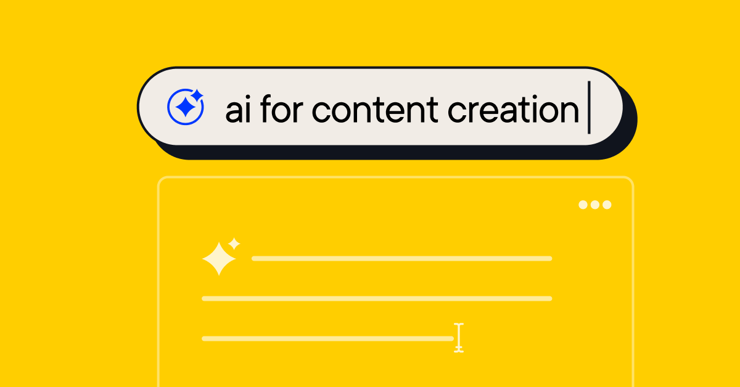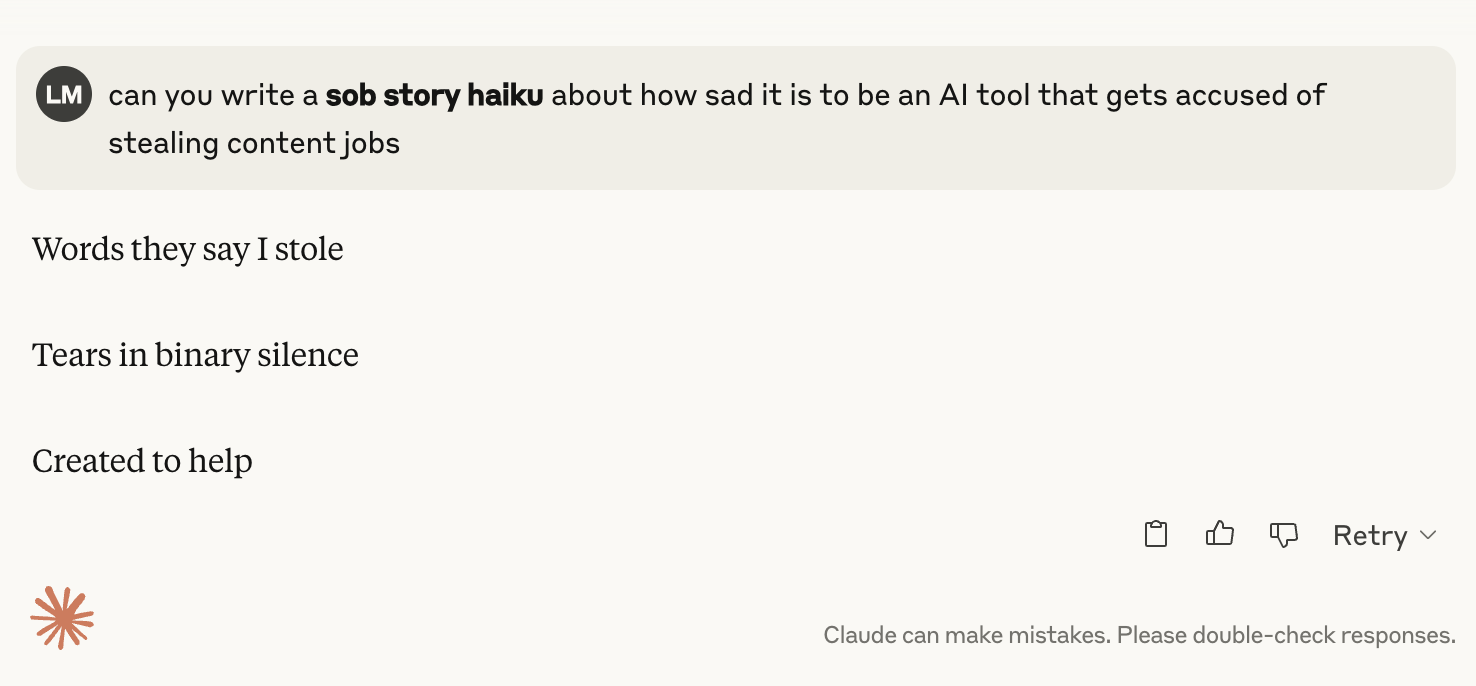
Production volume is one of the biggest content challenges that businesses face. With the pressure of producing at record speed for various channels and touchpoints, content creators are certainly feeling the heat.
But the thing is: content creation takes a lot time and resources.
That's why you've got to integrate AI into your content creation workflow. But before you go crazy on your favorite AI tool, here are the dos and don'ts of using AI for creating content.
✅ Dos: How to use AI in content creation
-
Ideation and brainstorming
Writer's block? No biggie. Creative burnout? Not a problem. AI is now a go-to for many content creators, marketers, and writers who are struggling with what to come up with next. Instead of staring at a blank page, use AI to generate those initial content concepts to spark your brain into action for ultra creative marketing campaigns.
Example prompt: "Generate 10 unique blog post ideas about sustainable marketing for a tech startup, focusing on innovative approaches that highlight environmental responsibility" -
Content briefs and outlines
On top of standard content research, AI can take on your content briefs too... yes, those of you that didn't know that already can all breathe a sigh of relief. We all know that those content briefs and outlines are helpful, but boy, are they time-consuming. By using AI to transform your ideas and additional research into content briefs, you free up way more time for the fun, creative side of things (without risk of going off on a tangent).
Example prompt: "Create an outline for a long-form article about digital transformation in healthcare, including key subtopics, CTA variations, and a suggested structure that balances technical insights with human interest stories" -
First draft generation
If you're feeling a lil bit low on creativity and need something to kick you off, AI tools can help you with an initial first draft. (But if you're an Ann Handley fan, there's nothing wrong with a very human and very messy first draft).
In fact, AI can help you with drafts across a variety of content formats, from blog posts to social media to image concepts. This approach is a rapid way to get a base or foundation for your content, ready to be refined and personalized by us humans.
Example prompt: "Write a first draft of a 800-word blog post about emerging marketing technologies, maintaining a conversational tone and including at least three industry-specific examples" -
Content optimization
Whether it's for SEO, segmentation, or just a splash of colour, sometimes content does need a little extra zhuzh (yes, that's how we're spelling it) to boost readability and engagement potential.
AI tools—like Optimizely Opal AI—can help refine your messaging, adjust tone, and ensure your content resonates with your target audience or different audiences. Find out more in the video below.
Example prompt: "Rewrite this blog post draft to target mid-level marketing managers, simplifying technical language and adding relevant industry benchmarks and practical implementation strategies" -
Data deep dives (AKA saving you a headache or two)
Make the most of AI tools to process and analyze vast amounts of data, saving you on time... and sanity. For example, input your target keyword data from tools like Semrush to create more targeted and insightful content in much less time.
The principle is simple: the better your input, the more valuable the output from AI.
Example prompt: "Analyze these six months of our website traffic data and social media engagement metrics, and generate insights about which content topics and formats are driving the most qualified leads"
❌ Don'ts: Where AI falls short for content creation
-
Plagiarism and originality issues
Risk: AI has got to get its information from somewhere, and that 'somewhere' is content that already exists on the internet. This means that AI-generated content isn't the most unique fish in the sea at the best of times, and often leads to generic content that lacks a distinctive voice.
Solution: There are a number of ways to detect AI content, but the main way to avoid plagiarism, imitation, and sometimes quite yawn-worthy content, is to invest time in adding your unique brand perspective and author voice. In short: Make sure you've got some real-life humans in that content workflow.
-
Factual accuracy and deep dives
Risk: There are things called AI hallucinations, and they are very, very real—and often, problematic. Basically, AI can confidently present inaccurate information through oversimplifying or even just lack of understanding, especially when continuing to prompt and prompt and prompt on the same chat chain.
Solution: Include a mandatory fact-checking task in your workflow if you're using AI in content creation—and make the most of subject matter experts if you have them—to cross-reference information to make sure you're keeping it real.
-
Emotional intelligence
Risk: Just like that guy your best friend dated last year, AI can lack emotional intelligence. It struggles to capture true human emotions, cultural sensitivities, and the genuine empathy that is needed to take your content over the line. Over the line and into the world of great storytelling, great brand building, and great engagement rates. 🌎
Solution: Human intervention... it's as simple as that. And don't get AI to write your sob stories...

AI for content creation best practices: Quick round-up
- Partner up and power up: Develop a collaborative human-AI content workflow.
- Get the team aligned: Set clear guidelines for AI tool usage across the content supply chain.
- Automate time-consuming tasks: Free up time for you to get more creative with your content.
Using AI in content creation: What's next?
More content, faster. What's not to love? But as always, human intervention is necessary if you want your content to stand out and win over your target audience.
Regurgitated and surface-level content is great for quick content research or providing first drafts, but when it comes to unique, on-brand content that has that wow-factor, you want to work together with AI in the perfect partnership.
Use AI to kickstart your creativity, bring out the (boring) content briefs, finalize that first draft, and free up your time so you can really get creative with your content.
Check out The AI Playbook: A practical guide to AI for marketers


